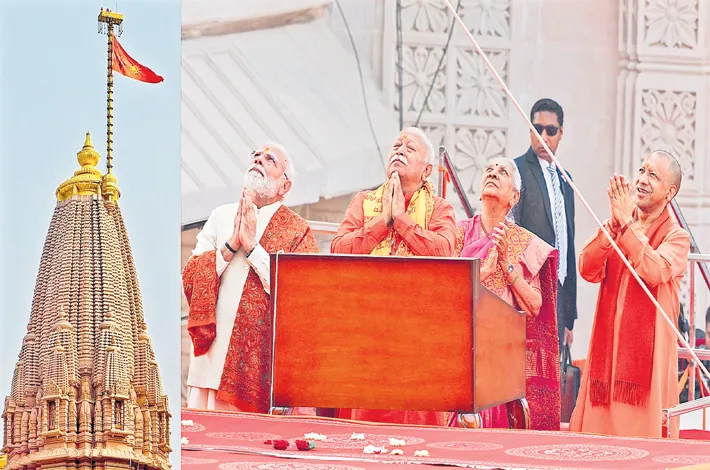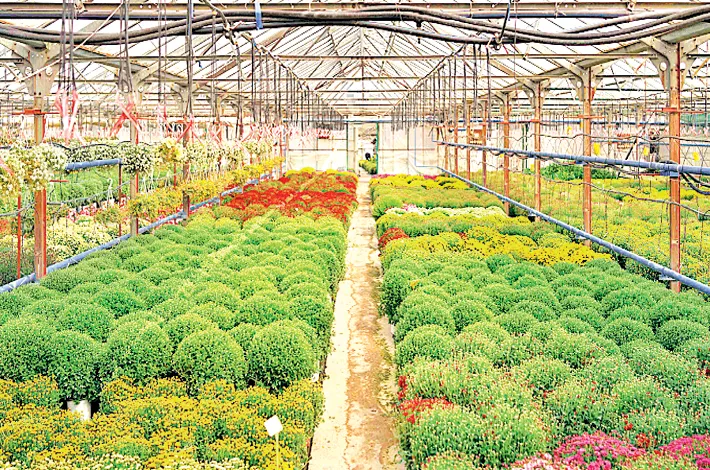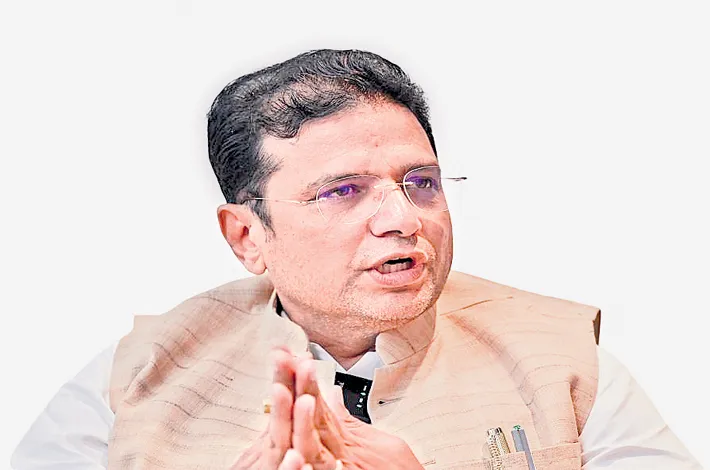Dharma Dhwaja Atop Ayodhya Ram Temple
26-11-2025 12:00:00 AM

metro india news I hyderabad
Prime Minister Narendra Modi on Tuesday hoisted ‘Dharma Dhwaja’ atop the 191-feet ‘shikhar’ of the Ram Janmabhoomi Temple in Ayodhya, marking the formal completion of the temple’s construction. RSS chief Mohan Bhagwat, Uttar Pradesh Chief Minister Yogi Adityanath and Governor Anandiben Patel were also present during the ceremony.
The flag-hoisting was conducted during the Abhijit Muhurat on Vivah Panchami, considered an auspicious period associated with Lord Ram and Goddess Sita. The Dharma Dhwaj, a triangular saffron flag measuring 11 feet by 22 feet, features three symbols: Om; the Sun, representing Lord Ram’s Suryavanshi lineage; and the Kovidara tree, linked with ancient plant hybridisation described in scriptures.
Before the ceremony, PM Modi performed a pooja at the Ram Lalla Garbha Grah along with RSS chief Bhagwat, CM Yogi Adityanath, and Governor Patel. He also visited Sheshavtar Mandir, Mata Annapurna Mandir, and Sapt Mandir, which is dedicated to Maharshi Vashishtha, Maharshi Vishwamitra, Maharshi Agastya, Maharshi Valmiki, Devi Ahilya, Nishadraj Guha and Mata Shabari.
Ayodhya soaks in devotional splendour
Ayodhya was soaked in devotional splendour on Tuesday as a grand flag-hoisting ceremony at the Ram temple concluded. The auspicious occasion, held on Vivah Panchami, saw the temple town turn into a vast cultural arena as more than 500 artistes from across Uttar Pradesh infused the city with music, dance and traditional performances under a cultural programme organised by the state's culture department.
Thousands of devotees streamed into Ayodhya earlier in the morning, chanting "Jai Shri Ram", as anticipation built for the ceremonial hoisting of the saffron flag -- the Dhwaj Arohan -- atop the temple's shikhar.
The rituals culminated with Modi raising the right-angled triangular flag, 10 feet high and 20 feet long, adorned with the Sun symbol, "Om" and the Kovidara tree. What followed was a resplendent display of Uttar Pradesh's folk traditions, with stages set up from the Maharshi Valmiki Airport to Ram ki Paidi reverberating with the sound of classical instruments, folk dances and devotional music.
More than 500 artistes participated in the event on Monday and Tuesday, presenting the Brij, Awadhi, Bundelkhandi, Purvanchali and Terai folk art forms. Musicians from Lucknow's Bhatkhande Culture University mesmerised the audience with shehnai, sarangi, pakhawaj, flute, sarod and sitar renditions. Sufi singing, bhajan performances and Brij folk vocals -- each group featuring seven to 12 artistes -- also drew large crowds.
The performers hailed from Unnao, Muzaffarnagar, Lucknow, Ayodhya, Varanasi, Prayagraj and other districts. A classical dance segment featuring Kathak, along with various folk styles, added further vibrancy to the cultural evening, showcasing the state's diverse and rich artistic heritage.
Tourism and Culture Minister Jaiveer Singh said the celebrations embodied Uttar Pradesh's unity in diversity. "On Vivah Panchami, the Dhwaj Arohan at the Ram temple is a symbol of our Sanatan faith, cultural traditions and national identity," he said.
"Artistes from different regions recreated the aura of the Treta Yuga. Their performances are a testament to the enduring strength of our heritage," he added.Earlier in the day, visiting seers and pilgrims spoke of the emotional significance of witnessing the flag-hoisting ceremony, calling it a "moment realised after centuries".








